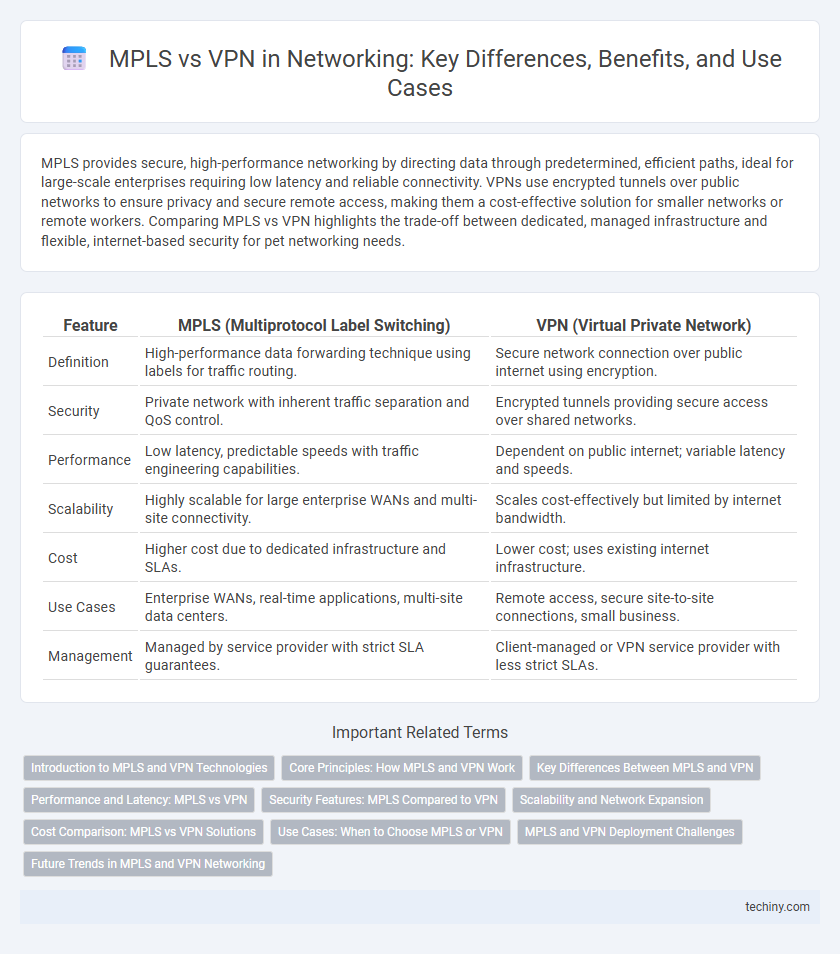MPLS provides secure, high-performance networking by directing data through predetermined, efficient paths, ideal for large-scale enterprises requiring low latency and reliable connectivity. VPNs use encrypted tunnels over public networks to ensure privacy and secure remote access, making them a cost-effective solution for smaller networks or remote workers. Comparing MPLS vs VPN highlights the trade-off between dedicated, managed infrastructure and flexible, internet-based security for pet networking needs.
Table of Comparison
| Feature | MPLS (Multiprotocol Label Switching) | VPN (Virtual Private Network) |
|---|---|---|
| Definition | High-performance data forwarding technique using labels for traffic routing. | Secure network connection over public internet using encryption. |
| Security | Private network with inherent traffic separation and QoS control. | Encrypted tunnels providing secure access over shared networks. |
| Performance | Low latency, predictable speeds with traffic engineering capabilities. | Dependent on public internet; variable latency and speeds. |
| Scalability | Highly scalable for large enterprise WANs and multi-site connectivity. | Scales cost-effectively but limited by internet bandwidth. |
| Cost | Higher cost due to dedicated infrastructure and SLAs. | Lower cost; uses existing internet infrastructure. |
| Use Cases | Enterprise WANs, real-time applications, multi-site data centers. | Remote access, secure site-to-site connections, small business. |
| Management | Managed by service provider with strict SLA guarantees. | Client-managed or VPN service provider with less strict SLAs. |
Introduction to MPLS and VPN Technologies
MPLS (Multiprotocol Label Switching) is a high-performance technique that directs data from one node to the next based on short path labels rather than long network addresses, optimizing traffic flow and reducing latency in large-scale networks. VPN (Virtual Private Network) technology creates a secure, encrypted tunnel over public or shared networks, enabling private communication and data integrity for remote access or site-to-site connectivity. Both MPLS and VPN provide reliable network solutions, with MPLS focusing on efficient routing within service provider networks and VPN emphasizing secure data transmission over diverse network environments.
Core Principles: How MPLS and VPN Work
MPLS operates by assigning labels to data packets, directing them across predetermined, high-performance network paths to optimize speed and reduce latency. VPNs create secure, encrypted tunnels over public or shared networks, ensuring data confidentiality and integrity between remote sites or users. While MPLS prioritizes efficient, label-switched routing within carrier networks, VPNs emphasize secure, authenticated connections over underlying IP infrastructures.
Key Differences Between MPLS and VPN
MPLS (Multiprotocol Label Switching) uses label-switching to route packets at high speed across private networks, offering superior performance, predictable latency, and QoS (Quality of Service) capabilities compared to VPNs (Virtual Private Networks), which rely on encryption over public internet connections. VPNs provide secure, encrypted tunnels for data transmission over shared networks, making them more cost-effective but less consistent in performance due to variable internet conditions. Key differences include MPLS's ability to prioritize traffic and provide SLAs (Service Level Agreements), while VPNs focus on data confidentiality and ease of deployment without the need for dedicated infrastructure.
Performance and Latency: MPLS vs VPN
MPLS offers superior performance and lower latency compared to traditional VPNs by routing data through predetermined, efficient paths within a private network, minimizing delays and packet loss. VPNs, relying on public internet infrastructure, often experience higher latency and variable performance due to congestion and dynamic routing. Enterprises seeking consistent low-latency connections with guaranteed SLAs typically prefer MPLS for mission-critical applications.
Security Features: MPLS Compared to VPN
MPLS networks offer enhanced security by isolating traffic through label-switching paths, reducing exposure to external threats compared to traditional VPNs that rely on public internet channels. MPLS provides robust traffic engineering and inherent privacy without encryption overhead, whereas VPNs use encryption protocols like IPsec to secure data over shared networks but may introduce latency. Enterprises favor MPLS for its predictable security model and performance, especially in multi-site WAN environments requiring traffic segregation and consistent service quality.
Scalability and Network Expansion
MPLS offers superior scalability for large enterprise networks by efficiently managing traffic through label-switched paths, enabling seamless network expansion without compromising performance. VPNs, while flexible and cost-effective for secure remote access, can face challenges scaling due to encryption overhead and reliance on underlying public infrastructure. Enterprises aiming for extensive network growth benefit more from MPLS's robust, carrier-grade scalability and predictable QoS features.
Cost Comparison: MPLS vs VPN Solutions
MPLS networks generally incur higher costs due to dedicated infrastructure, guaranteed QoS, and extensive SLA management, making them suitable for enterprises requiring high performance and reliability. VPN solutions leverage existing internet connections, offering a cost-effective alternative with flexible scalability but potentially compromised latency and security. Companies with budget constraints often prefer VPNs, while those prioritizing consistent service quality and network control tend to invest in MPLS despite the premium pricing.
Use Cases: When to Choose MPLS or VPN
MPLS is ideal for enterprises requiring high-performance, low-latency connections across multiple sites with guaranteed SLA and better traffic engineering capabilities. VPN is suitable for cost-effective, flexible secure remote access, especially for smaller organizations or those with distributed workforces using the public internet. Choosing MPLS or VPN depends on prioritizing either robust reliability and performance or affordability and ease of deployment for secure site-to-site or remote connectivity.
MPLS and VPN Deployment Challenges
MPLS deployment challenges include complex configuration requirements and high costs associated with dedicated infrastructure and service-level agreements. VPN deployment faces obstacles such as ensuring secure tunneling over public networks and managing scalability issues when connecting multiple remote sites. Both MPLS and VPN demand careful integration with existing network architectures to maintain performance and reliability.
Future Trends in MPLS and VPN Networking
Future trends in MPLS and VPN networking emphasize increased integration with software-defined WAN (SD-WAN) technologies, enhancing flexibility and control over network traffic. The adoption of automation and AI-driven analytics improves performance optimization and security management in complex multi-site environments. Growing demand for cloud connectivity and 5G adoption drives the evolution of MPLS and VPN solutions toward more scalable, resilient, and low-latency architectures.
MPLS vs VPN Infographic

 techiny.com
techiny.com